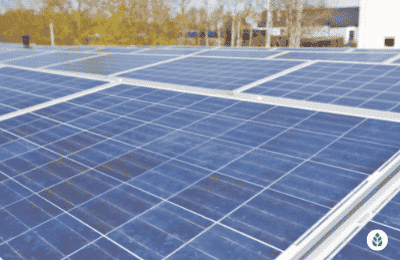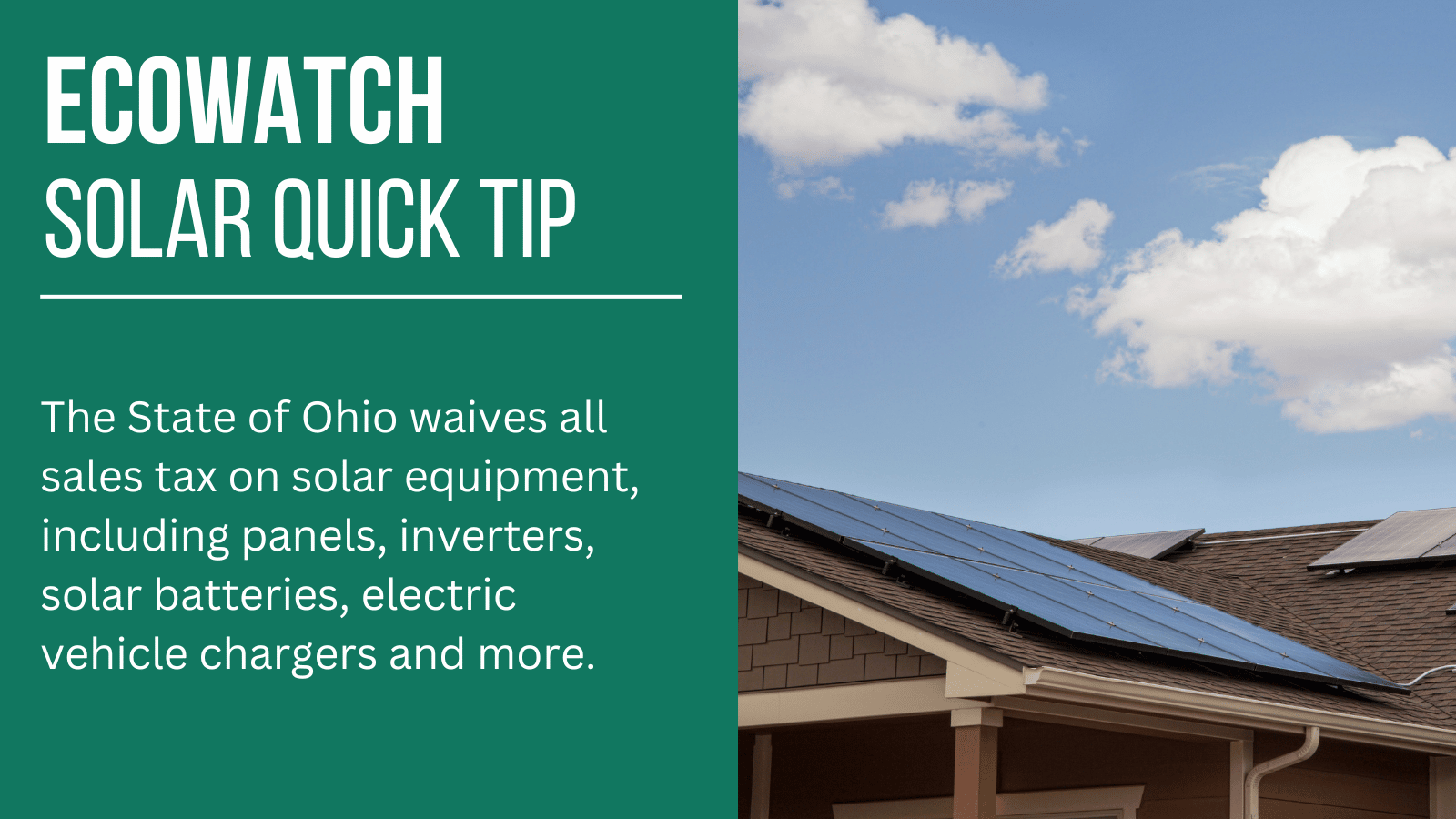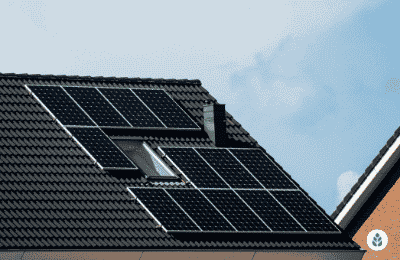 Reviews
Reviews
Solar Panel Cost in Ohio (2024 Local Savings Guide)
In this guide to determining the cost of solar panels in Ohio, you’ll learn:
- How much do solar panels cost in Ohio?
- How can you save money when going solar in Ohio?
- What ongoing costs should you expect after installing solar panels in Ohio?
Each product and or company featured here has been independently selected by the writer. You can learn more about our review methodology here. If you make a purchase using the links included, we may earn commission.
What Is the Cost of Solar Panels in Ohio?
Installing residential solar panels is cheaper in Ohio than in many other areas of the nation. The average cost of solar panels in Ohio is $3.19 (compared to the U.S. average of $3.33 per watt). We’ve also found that the typical Ohio homeowner will need to install a 9-kilowatt (kW) or a 10-kilowatt (kW) solar photovoltaic system to offset the average monthly electric bill of $138.1 Using these figures, we can calculate that the average Ohio solar array costs a total of about $28,710.
The price of a solar panel installation in Ohio can vary based on a number of factors, including the size of your home and how much direct sunlight your roof receives (angles are key for efficiency). While prices may vary, don’t forget to factor in tax credits and other solar incentives that can lower the upfront cost of going solar in Ohio.
While long gray winters may have some wondering if it’s worth going solar in Ohio, plenty of homeowners in the Buckeye State say they get enough power generation from the sun to justify their switch to clean energy.2 Plus, solar prices have fallen 11% over the past five years, which has a lot of people switching over to solar to reduce their overall energy costs.3

Blue Raven Solar
Pros
- Industry-leading in-house financing
- Competitive pricing
- Excellent reputation
Cons
- Doesn't offer solar batteries (coming 2022)

Icon Solar
Regional Service
Average cost
Pros
- Many years of experience
- Comprehensive service offerings
- Great warranty coverage
Cons
- No leases or PPAs
How Much Do Solar Panels Cost in Ohio?
The average solar energy system in Ohio costs approximately $20,097 after the federal solar tax credit is considered. Before the credit, the average total is closer to $28,710.
These numbers take into account a few factors, including:
- Your home square footage is around the average for Ohio
- Your monthly electric bills are around the statewide average of $138.37 and you can offset energy costs with the typical solar system size in Ohio of 9 kilowatts (kW)1
- You pay the average cost per watt in Ohio of $3.19
The price of your system can fluctuate depending on several other factors, like the type of equipment you choose, the installer you hire and even the direction your home faces, which determines solar production to some extent.
Most residents pay between $13,398 and $26,796 for their solar systems after taking advantage of the federal solar tex credit and Ohio’s sales tax exemption. Before the federal tax credit is applied, solar system prices in Ohio usually range from $19,140 up to $38,280.
The table below includes the average price for different system sizes we often see installed in Ohio, along with the appropriate square footage for each size.
| Size of Your Solar Panel System | Typical Cost in Ohio (Before Tax Credit) | Cost After Federal Tax Credit | Average Home Size the System Can Support |
| 6 kW | $19,140 | $13,398 | 1,000 sq. ft. |
| 7 kW | $22,330 | $15,631 | 1,200 sq. ft. |
| 8 kW | $25,520 | $17,864 | 1,400 sq. ft. |
| 9 kW | $28,710 | $20,097 | 1,600 sq. ft. |
| 10 kW | $31,900 | $22,330 | 1,800 sq. ft. |
| 11 kW | $35,090 | $24,563 | 2,000 sq. ft. |
| 12 kW | $38,280 | $26,796 | 2,200 sq. ft. |
How Does the Current Cost of Solar in Ohio Compare to the National Average?
The average cost per watt for solar photovoltaic (PV) equipment across the U.S. is $3.33. Your money goes a little further in Ohio, where the average cost per watt is $3.19. For every kW of solar capacity you install in Ohio, you’ll pay approximately $140 ($0.14 per watt) less than you would in most other states.
Ohio residents use around the same amount of energy as the national average, so the system size requirement is about the same in the Buckeye State as it is elsewhere. Still, the lower per-watt price in Ohio means you will have slightly lower overall costs on your solar power system.
Watch Below: Learn How Solar Panels Are Becoming So Efficient
How Are Solar Costs Trending in Ohio?
The Solar Energy Industries Association (SEIA) reports that the average cost of solar equipment in Ohio has gone down by around 53% over the past 10 years.2 The average system price of $20,097 in Ohio today used to total approximately $40,000 just a decade ago.
The drop in solar equipment costs is thanks, in large part, to continued research and production within the solar industry. Panels have become more and more efficient, which means less equipment is now needed to provide sufficient power for Ohio homes.
Plus, the manufacturing process for PV equipment has become far more efficient, streamlined and affordable. This has also contributed to a decrease in costs across the board.
While solar conversion costs are on the decline, the cost of electricity is on the rise. Electricity rates in the Midwest have increased from an average of 12.4 cents per kilowatt-hour (kWh) in 2012 to 15,8 cents per kWh in 2024.3 The rising energy rates are attributed to fossil fuels becoming more challenging to source.
With PV equipment at its most affordable in the last decade and energy prices continuing to increase, you can more clearly see why converting to solar is a beneficial option in Ohio.
How Much Can You Save by Going Solar in Ohio Today?
When you go solar in Ohio, the cost of your monthly electric bills is offset by the solar electricity your system generates. The average solar customer in the Buckeye State will see savings that pay off their system entirely and save an additional $32,468 after that.
This number is conservative, as current electricity rates are used to determine estimated savings. With electricity prices on the rise in Ohio, you will likely see even greater savings over the lifespan of your system.
Additionally, these savings assume you purchase your system in cash. Choosing a different payment method will affect your total system price, as well as your long-term savings.
In the chart and sections below, we’ll outline the three primary payment options available to solar customers in Ohio and explain how each can affect your solar costs over time.
| Solar Financing Option | Initial Cost | Payback Period | Est 25-Year Savings |
| Cash | $20,097 (after the federal credit) | 11 years* | $32,468* |
| Loan | Often $0, but higher down payments can reduce your payback timeline and your total interest paid | 14 years* | $28,000* |
| Lease | Usually $0 | N/A | $6,000 |
*These are conservative estimates intended to represent base-level averages. In most cases, customers can see an even higher return on investment (ROI) and shorter payback periods.
Cash Purchase of Solar System
Buying your solar panel system in cash allows you to avoid the interest that would be tacked onto your total if you opted for a loan instead. You’ll enjoy a few key benefits when you choose to pay for your system in cash:
- You’ll pay the lowest price possible for your system.
- You’ll maximize your long-term savings.
- You’ll see the greatest ROI of any payment method.
Using cash to purchase your system will also give you access to all of the solar incentives in Ohio. Namely, you’ll be able to claim the federal credit — an average value of $8,613 in Ohio — which you can’t consider if you opt for other payment methods like a lease.
Paying in cash means you’ll begin saving money immediately. Since you won’t have a monthly equipment payment as you would with a loan or lease, all of the savings you see on your utility bills will go toward offsetting electricity costs and paying off your system until you break even.
After your panels pay for themselves — the average payback period is 11 years in Ohio — all your energy savings will be a return on your investment.
The main drawback of a cash purchase is that it’s the least accessible payment option. You’ll need to be able to cover the entirety of the system price as an initial payment. In Ohio, you can expect to pay an average of $28,710, which may be out of the question for many homeowners.
Below are some of the upsides and downsides of choosing a cash purchase to fund your solar project.
Pros of a Cash Purchase in Ohio
- Leads to panel ownership
- Avoids interest payments, reducing your total system price
- Yields the highest overall savings on electric bills
- Fastest possible panel payback timeline
- You can claim the federal solar tax credit
- Provides the highest return on investment
Cons of a Cash Purchase in Ohio
- Requires the highest initial payment
Solar Loan
Using a loan to acquire your PV system is much more accessible than paying cash, especially since many financiers offer $0-down options. Rather than paying for your system all at once, you can take out a loan and make monthly payments until you pay off your equipment.
In many cases, your lender can make your monthly payment equal to or less than your current monthly expenses for electricity. In Ohio, that’s around $138 or less.4 This is a convenient way to begin saving on energy costs and still be on track to own your panels.
The downside to taking out a loan for your PV equipment is that you’ll pay an interest rate on the system total. Over the length of your financing agreement, that interest will add up and increase the total cost of your equipment. On average, most solar customers who finance their panels pay $5,000 more overall due to interest.
This added cost means it will take you longer — about three years more in Ohio — to pay off your panels. Although you’ll have a longer payback period, solar financing still leaves room to see a return on your investment.
You can also claim the federal solar tax credit and other incentives when you choose a solar loan.
Below are some pros and cons of going solar with a loan.
Pros of a Solar Loan in Ohio
- Leads to panel ownership
- Provides more savings than a lease
- Requires minimal or no money down
- More accessible than a cash purchase
Cons of a Solar Loan in Ohio
- Interest drives up your all-in system price
- Your overall savings are lower than with a cash purchase
- Longer payback timeline
- Requires good credit and a credit check
Solar Lease
A solar lease is an arrangement where you pay a fixed monthly payment for your panels and, in exchange, can use the electricity they produce to lower your energy bills. Since you’ll be leasing your panels, there is no payback period and you’ll never own the equipment.
Leases used to be considered a better option than they are now when solar loans were less appealing and beneficial. Leases rarely have down payment requirements, which made them one of the most accessible options before loans were offered with similar $0-down requirements.
Leases can still be beneficial for individuals who cannot take the federal tax credit — if you don’t expect to owe income taxes for at least five years after you install your solar panels — and who want to see immediate savings. Most leasing companies can structure your lease so your monthly payment falls below your typical monthly energy costs.
Leases come with some pretty significant downsides, though. Most notably, they lead to the lowest overall savings on electric bills — usually a little less than a third of what you’d see from a cash payment and less than half what you’d see with a loan.
As we mentioned above, leases also don’t let you take the federal credit, the value of which averages around $8,613 in Ohio. This is also a downside of choosing a power purchase agreement (PPA), which is another financing option that requires no money down.
Below are some of the benefits and drawbacks of using a lease to acquire your PV panels.
Pros of a Solar Lease in Ohio
- Usually requires no money down
- Maintenance and system repairs are typically included
- You can support renewable energy without a sizable investment
- Credit requirements are often not as strict as loans
Cons of a Solar Lease in Ohio
- Requires a credit check and decent credit
- You can’t claim the federal tax credit
- Leads to the lowest overall savings
- Doesn’t lead to panel ownership
If you’re not sure which payment option is right for you, or you’re curious to see monthly and all-in system costs for each option, you can use this solar calculator to estimate costs and savings for your Ohio home.
How Do You Get the Best Solar Prices in Ohio?
Since solar systems average $28,710 in Ohio before any incentives, most aspiring solar customers in the state look for ways to keep conversion costs down. There are a few things you can do to bring down your effective costs and ensure you get the most out of your PV panels, including:
- Take advantage of the federal tax credit
- Take advantage of net metering in Ohio
- Consider installing a solar storage solution
- Invest in high-efficiency panels
In the sections below, we’ll explain why each of these tips can save you money and improve your long-term solar savings.
Take Advantage of the Federal Tax Credit
The federal government offers what we believe is the most beneficial solar benefit program in the U.S.: the federal solar investment tax credit (ITC). This credit — in the amount of 30% of your entire system value — gets applied to your income taxes for the year your system is installed and commissioned. In Ohio, that’s an average of just over $8,600.
This is not a rebate, so you’re not guaranteed to get the full amount. Rather, it can reduce the amount of income taxes you owe, which means you won’t be able to take the full credit if you don’t owe at least $8,600 in taxes. You can, however, take a partial credit and roll over the rest for up to five years.
Provided you can take the full credit, you can effectively bring your all-in system price down from an average of $28,710 to $20,097.
Take Advantage of Net Metering in Ohio
Net metering is a policy that’s mandated for all investor-owned utilities (IOUs) by the Public Utility Commission of Ohio (PUCO). It states that all IOUs must credit your account for any excess solar energy you generate and send back to the electric grid. Those credits then get applied to future bills, which helps you bring down your long-term electricity costs.
Net metering is available to all Ohio residents. Although utility companies aren’t required to provide energy credits equal in value to the kilowatt-hours (kWh) you pull from the grid, the program still has several benefits, including:
- Reducing your effective electricity rates
- Reducing your panel payback timeline
- Maximizing your energy savings over time (depending on your energy needs)
Consider Solar Batteries
Another option to help you save more money on electricity in the long run — and effectively get more return on investment out of your system — is installing solar batteries. Energy storage options not only allow you to maintain power during outages, which are common in Ohio but can also help you bring down your effective costs for energy.
Without batteries, your home will still pull electricity from the grid whenever your panels don’t produce enough to cover your energy usage. This is most common at night or on cloudy days when the available sunlight is diminished.
Since Ohio utility companies don’t have to credit you for excess energy production at the full retail rate, the energy you send to the grid doesn’t benefit you as much as if you used it yourself. Solar batteries allow you to store what you produce and get the full value for it when you need it. This helps pay off your system more quickly and saves you more over time.
Choose High-Efficiency Panels
Ohioans see an average of just 173 sunny days per year, which pales in comparison to the U.S. average of 205 days.5 With less available sunlight than most states, Ohio is a good place to invest in high-efficiency panels, which can take better advantage of the sunlight that is available and maximize energy savings.
Panels that generate more electricity with the available sun will also earn you more Solar Renewable Energy Credits (SRECs). These help you pay down your system more quickly and save you more over time.
There are many different brands of high-efficiency, monocrystalline panels that work well for Ohio systems, most of which come with outstanding warranty coverage. These include:
- Maxeon (SunPower)
- Panasonic
- Tesla
- Canadian Solar
- Q Cells
- REC
What Factors Affect the Cost of Solar Panel Systems in Ohio?
It’s not uncommon for Ohio residents to pay anywhere between $13,398 and $26,796 for their solar energy systems. The range is so wide because there are a few factors that can bring your total cost up or down. We’ll explain the most significant factors in the sections below.
Solar Equipment
The specific equipment you have installed on your home is one of the most significant cost factors to consider. The quality and efficiency of your panels can account for thousands of dollars in varying prices per system.
Ohio receives just 173 sunny days per year, which means highly efficient panels — which tend to be more expensive — are typically required to offset electric bills. This can lead to higher overall costs for Ohio residents.
The state is also prone to severe weather including tornadoes, lake-effect snowstorms and intense thunderstorms. Blackouts can be common, so many solar customers choose to add solar batteries to their setups.
Solar storage devices can add thousands — or tens of thousands, in the case of Tesla Powerwalls — to your total costs. The tendency for homeowners to include batteries in their solar array drives up the average cost of solar systems in Ohio.
Solar Financing in Ohio
Loan options is another factor that can affect your initial and total system costs.
Paying cash gives you the greatest savings over time but also requires a sizable upfront cost. Using a loan reduces your upfront payments but adds an interest expense, ultimately raising the total cost of your system.
There are some low-cost and low-interest financing options in Ohio that make loans more affordable and accessible. For example, Ohio PACE offers its Property Assessed Clean Energy (PACE) program, which provides easy access to low-APR loans for solar equipment.
Ohio also offers the Energy Conservation for Ohioans (ECO-Link) program, which aims to provide low-cost financing for solar equipment.
There are currently no solar financing programs specifically for low-income households in Ohio.
Ohio Solar Installation Company
The installation company you choose will also impact your system total. Each company has its own pricing for equipment and labor. Even if you get the exact same system from two different companies, the pricing from one could be thousands of dollars lower than from the other.
Generally speaking, local solar companies in Ohio — like Ohio Power Solutions and Icon Solar — tend to have higher equipment prices because they don’t buy panels in bulk. But they often provide better customer service, and they can sometimes offer discounts to help reduce the price of solar.
The national companies that operate in Ohio — like SunPower, YellowLite and Paradise Energy Solutions — often have lower equipment costs but typically provide fewer customization options.
It’s best to look at more than the price when it comes to choosing a solar system installer. For example, SunPower only offers Maxeon panels in Ohio, which are some of the most expensive in the industry but also offer the highest efficiency rating and an industry-leading warranty.
Ohio Power Solutions provides access to Solar Edge panels, which are more affordable but not as efficient. So while Ohio Power Solutions will tend to be less expensive than SunPower, you also won’t be getting the best solar panels the industry has to offer.
Are There Any Maintenance Costs When Going Solar in Ohio?
Most solar customers in Ohio will not see any ongoing costs for PV panel maintenance.
One ongoing cost you may run into is panel removal and replacement if you ever need to repair or replace your roof. A reputable solar installer should notify you if you need roof repair or replacement before your panel installation, which should help eliminate maintenance costs in the future.
If you do need to remove and reinstall your panels, you’ll likely pay between $500 and $1,000 for the service.
One of the only other maintenance costs some solar customers pay is for panel cleaning. Routine cleaning removes dirt, pollen and other debris from the surface, which can build up over time and cause a dip in efficiency and power production.
Most of Ohio sees above-average amounts of rainfall each year and the precipitation should help keep your panels clean year-round.6 If you do find yourself needing a cleaning service, most companies charge between $50 and $150.
Typical Costs of Solar Providers in Ohio
The Solar Energy Industries Association (SEIA) reports that there are nearly 60 solar companies that service Ohio.7 That means you’ll have plenty of options to choose from to ensure you get an installer that meets your needs and fits into your budget.
The company you choose will determine your overall experience of converting to renewable energy and, in part, the cost of your total system. We’ll include some relative pricing guidelines for our recommendations for the best solar companies in the Buckeye State in the table below.
| Solar Installer | Average Installation Cost Per Watt ($-$$$$$) |
| Yellowlite | $$$ |
| Paradise Energy Solutions | $$ |
| Ohio Power Solutions | $$$$ |
| SunPower | $$$$ |
| Blue Raven Solar | $$ |
| Icon Solar | $$$ |
Read More About Going Solar in Ohio
- Best Solar Installers for Your Home in Ohio
- Guide to Ohio Solar Incentives
- Is Going Solar Worth It in Ohio?
The cost information presented in this article is derived from a comprehensive analysis, incorporating data from multiple industry sources. The average cost per watt per state was calculated based on figures from Consumer Affairs, Energy Sage, and Berkeley Lab’s Electricity Markets & Policy Department. Additionally, monthly energy consumption and the average monthly cost of electricity were sourced from the U.S. Energy Information Administration, ensuring a well-rounded and accurate representation of the information presented.
FAQ: Ohio Solar Panel Costs
The EcoWatch team fields many questions from Ohio homeowners looking to go solar. If you have specific questions that aren’t answered here, reach out to our team of solar experts at solar@ecowatch.com.
The average cost of PV panels in Ohio is $3.19 per watt, which puts the average 9-kilowatt home solar system in Ohio at $28,710. A solar power system in Ohio also qualifies for the 30% federal credit, which would give you an additional savings of about $8,613.
Yes! Data from Zillow shows that adding solar boosts property value and that homes with solar panels tend to sell for 4.1% more than homes without.8 It’s important to remember that you can only capitalize on the increase of your Ohio home’s value if you own your solar system and not if you have a solar lease.
Some solar customers in Ohio will also have access to a property tax exemption. This makes the value bump even more appealing, as it guarantees your property taxes won’t go up as a result of your solar system.
In Ohio, it’s possible to fully eliminate your electric bills, but it will be tough without a battery and high-efficiency solar panels.
It will also depend on if you have enough space on your roof to fit the necessary amount of solar panels, and if your budget allows you to purchase a large enough system.
In Ohio, the average homeowner requires a 9 kW system or larger to fully offset their electricity bills.
As the net metering program in Ohio varies by provider, it’s also not guaranteed that your utility company will compensate you at a high enough rate to offset your bills. As a result, most Ohio solar customers won’t be able to offset costs without a way to store their own energy.
Top Solar Installers in Ohio Cities
Comparing authorized solar partners
-
- Industry-leading in-house financing
- Competitive pricing
- Excellent reputation
- Doesn't offer solar batteries (coming 2022)
A+Best Solar Financing2014Trina Solar, Canadian Solar, SolarEdge, Silfab, SunPower25-year manufacturer warranty; 10-year workmanship warranty, 2-year production guarantee
Having trouble deciding? Click below and use our process to receive multiple quotes instead:

 233k
233k  41k
41k  Subscribe
Subscribe 








